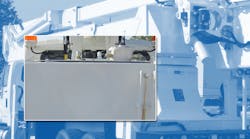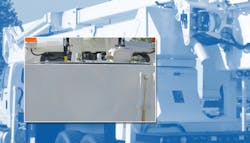Hydraulic reservoirs in mobile equipment can be prone to corrosion when humid air is drawn in when oil level drops. Once moist air gets into the reservoir, water can condense on the interior walls of the reservoir when the ambient temperature drops. Desiccant breathers can be specified to filter and dry ambient air drawn into the reservoir. However, the desiccant has a finite service life, so if the breather is not changed at recommended intervals, moisture will be drawn in unimpeded.
The condensate, ultimately, will enter the hydraulic system and pose several problems. The condensate will also adhere to the interior surfaces of the reservoir, which could lead to rust deposits that can also enter the hydraulic system. These deposits can cause problems of their own, including premature wear to components, clogging of filters and orifices, and valve malfunctions.
IFH (Innovative Fluid Handling) Group, Rock Falls, Ill., doesn’t make desiccant breathers, so they can’t help dry the air drawn into a reservoir. But they do make reservoirs made of aluminized steel, which helps prevent corrosion if moisture does get into the reservoir. IFH Group pioneered the use of aluminized steel in hydraulic-oil reservoirs and fuel tanks for off-road and specialty vehicles used in agricultural, construction, utility, mining, and other applications.
Aluminized steel is sheet carbon steel that is hot-dip-coated on both sides with an aluminum-silicon alloy to avoid the contamination problems inherent to uncoated steels. Essentially, aluminized steel combines the corrosion resistance of aluminum with the higher mechanical strength — and lower cost — of steel. Aluminized-steel reservoirs are compatible with virtually all petroleum-based and synthetic fluids while also providing protection from atmospheric corrosion. Each reservoir is customized to specifications and is available in capacities from 1 to more than 300 gallons.
Ryan McCarty, of IFH Group, explains, “Unlike off-the-shelf units, custom made hydraulic reservoirs are designed to fit the exact space and technical requirements for optimal performance of the off-road machine or other mobile equipment.” IFH manufactures hydraulic reservoirs, fuel tanks, and other vessels from mild steel, stainless steel, and aluminum as well as aluminized steel. “We use whichever material is best suited to the application,” added McCarty, “whether it’s a forklift, combine, boom crane, or a specialized military vehicle.”
All reservoirs and tanks are delivered clean and pressure-tested. Once the vessel has been made, IFH can provide powder coating, chemical agent resistant coating, and subassemblies, including the addition of component parts such as fill caps, filler breathers, sight gages, sending units, hoses, and more. “We offer everything from a simple two-part tank strap to hydraulic reservoir tanks with more than 60 different parts,” noted McCarty. So as it turns out, even though IFH doesn’t make desiccant breathers, it can provide one with the reservoir if it is so specified.
For more information, contact The IFH Group Inc., at (800) 435-7003; e-mail [email protected], or visit www.ifhgroup.com.


